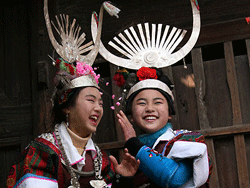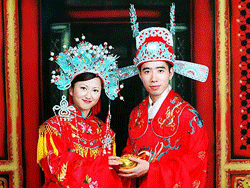Chinese people were wearing silk while other cultures were still dressing in animal skins.  Clothing in China did not only evolve over time; it often transformed dramatically following Dynastic changes or the Imperial decree of a new ruler. In ancient feudal society, people’s rank and position could easily be distinguished from their daily dress, especially for the ordinary people and upper-class.
Clothing in China did not only evolve over time; it often transformed dramatically following Dynastic changes or the Imperial decree of a new ruler. In ancient feudal society, people’s rank and position could easily be distinguished from their daily dress, especially for the ordinary people and upper-class.
Among the upper dominating class, only to the Emperor was assigned the colour yellow and the dragon emblem on traditional Chinese imperial dress as an exclusive affirmation of their power.
There is no “typical” Chinese costume, although today, if any one style of clothing epitomises “Chineseness”, it would be the Cheongsam, or Qipao, which evolved from ancient clothing of the Manchu ethnic minority. Popular because it fits the Chinese  female figure well, has simple lines and looks elegant; it is suitable for wearing in all seasons by young or old and can either be long or short. It is recognised around the world and has inspired many foreign adaptations because of its simple yet exotic lines. It is popularly worn in northern China as the wedding dress, traditionally Red, embroidered with elaborate gold and silver designs. Brides in southern China wear Qipao or a two-piece dress name Qungua or Kwa, which is also elaborately adorned with a gold dragon and phoenix pattern.
female figure well, has simple lines and looks elegant; it is suitable for wearing in all seasons by young or old and can either be long or short. It is recognised around the world and has inspired many foreign adaptations because of its simple yet exotic lines. It is popularly worn in northern China as the wedding dress, traditionally Red, embroidered with elaborate gold and silver designs. Brides in southern China wear Qipao or a two-piece dress name Qungua or Kwa, which is also elaborately adorned with a gold dragon and phoenix pattern.
History of Chinese Clothing
China has many ethnic groups with a long history while Han people dominate most periods in history. For thousands of years, generations of clothing designers have devoted themselves to building the Kingdom of Clothes, making the garments that cover  the human body into an important component of Chinese culture. The progress of nation can be seen through its changes in clothing styles.Clothing manufacture in China dates back to prehistoric times, at least 7,000 years ago.
the human body into an important component of Chinese culture. The progress of nation can be seen through its changes in clothing styles.Clothing manufacture in China dates back to prehistoric times, at least 7,000 years ago.
Features of Chinese Clothing
Because of relatively plain design and structure of traditional Chinese clothing, embroidered edgings, decorated bands, draped cloth or silks, patterns on the shoulders, and sashes were often added as ornamentation. These varied designs came to be one of the unique features of traditional Chinese dress. Darker colours were much more favoured than lighter ones in traditional Chinese clothing so the main color of ceremonial clothing tended to be dark.
Types of Chinese Clothing
Three main types of traditional Chinese clothing are the pienfu, the changpao, and the shenyi. The pienfu is an ancient two-piece  ceremonial costume of a tunic-like top extending to the knees and a skirt or trousers extending to the ankles. The changpao is a one-piece garment extending from the shoulders all the way to the heels. The shenyi is a cross between the pienfu and the changpao; it consists of a tunic and a skirt or trousers like the pienfu.
ceremonial costume of a tunic-like top extending to the knees and a skirt or trousers extending to the ankles. The changpao is a one-piece garment extending from the shoulders all the way to the heels. The shenyi is a cross between the pienfu and the changpao; it consists of a tunic and a skirt or trousers like the pienfu.
Well-known Chinese Clothing
The costume of the Western Han Dynasty (206BC-8AD) followed the one established in the Qin Dynasty (221-206 BC). In the Eastern Han Dynasty, people in black had to wear purple silk adornments to match their clothes. Ordinary people usually wore a costume with a long hat at grand ceremonies offering sacrifices to gods or ancestors. The dress of the queen in these ceremonies consisted of dark-purple frock and black trousers.
Chinese Imperial Dressing
In ancient feudal society, it is easy for people to be distinguished from his daily dress, especially for the ordinary people and up per-class. For the sake of working and low statue, ordinary people usually wear dress of linen in dark colours, while upper-classes prefer the dress made of silk with many valuable decorations. Among the upper dominated class, the Emperor, without any doubt, designated the colour yellow and the dragon emblem on traditional Chinese imperial dress.
per-class. For the sake of working and low statue, ordinary people usually wear dress of linen in dark colours, while upper-classes prefer the dress made of silk with many valuable decorations. Among the upper dominated class, the Emperor, without any doubt, designated the colour yellow and the dragon emblem on traditional Chinese imperial dress.
Costumes of Ethnic Minorities
Clothes of Chinese ethnic minorities are flowery, colorful, extremely exquisite, and highly distinctive. They play an important role  of the rich history and culture of the ethnic groups. Every aspect of their garments, such as raw materials, textile technology, fashion and decoration, retains a distinct characteristic of the ethnic group and the locality. The Hezhen ethnic minority people, who mainly make a living on fishing, used to make clothes with fish.
of the rich history and culture of the ethnic groups. Every aspect of their garments, such as raw materials, textile technology, fashion and decoration, retains a distinct characteristic of the ethnic group and the locality. The Hezhen ethnic minority people, who mainly make a living on fishing, used to make clothes with fish.
Chinese Wedding Dress Red is favorite for all Chinese people, for red is considered as good luck that can keep evil spirits away. The traditional Chinese wedding dress in northern China usually is a one piece frock named Qipao, embroidered with elaborate gold and silver design. Brides in Southern China prefer to wear two-piece dress name Qungua or Kwa, which also elaborately adorned with gold dragon and phoenix.
Red is favorite for all Chinese people, for red is considered as good luck that can keep evil spirits away. The traditional Chinese wedding dress in northern China usually is a one piece frock named Qipao, embroidered with elaborate gold and silver design. Brides in Southern China prefer to wear two-piece dress name Qungua or Kwa, which also elaborately adorned with gold dragon and phoenix.




.png)









